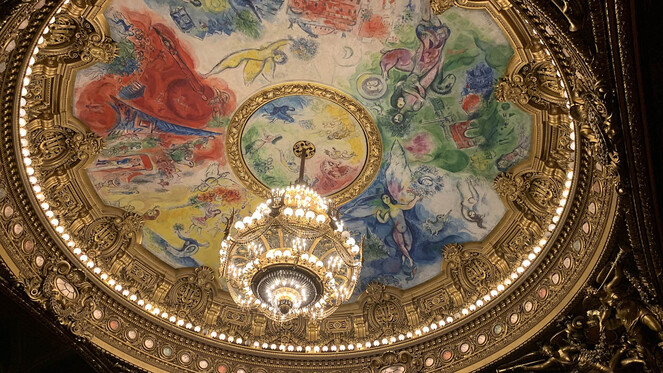Visit the Opéra Garnier
Charles Garnier was 35 years old when he won the competition in 1861 for the construction of an "Imperial Academy of Music and Dance". The construction project was commissioned by Emperor Napoleon III in the aftermath of the attack on the Opéra, on rue Le Peletier, of which he had been the target. It took fifteen years to complete the construction. The hall of the Opera on rue Le Peletier was burned down in 1873, which contributed to hastening the completion of the Opéra Garnier.

Construction site of the Garnier Opera House in 1866

The Garnier opera house around 1900
Visit of the Palais Garnier
Vidéo 2’:
The visit is priced at 14€ and 9€ in reduced rate. It is free for children under 12 years old. It gives access to all parts of the Opera except for the back offices (backstage, machinery, rehearsal rooms, costume room...)

The opera house is currently undergoing work on the façade. You will not enter through the main entrance but it will be accessible to you.



The grand staircase alone is a real wonder for its materials, its dimensions and the elegance of its lines. The steps are made of Seravezza marble, the balustrade is made of onyx, the base is made of green Swedish marble and the balusters are made of antique red marble.
The richness of the decorations can be seen in the frescoes, statues and overall in the variety, quantity and sophistication of the ornaments.

Inspired by the galleries of castles such as the Hall of Mirrors in Versailles, the decoration of the grand foyer is provided with sculptures, gilding, paintings, chandeliers and an abundance of shapes and colors in a particularly busy and rich style, typical of the Second Empire style.


The design of the Italian-style halls is sometimes questioned, as they offer a large number of boxes with greatly reduced visibility. It must be taken into account that many of these boxes were used more to be seen than to see the show.
Tired of the royal blue that was too often overused, Charles Garnier used "deep red" velvet, shimmering and bringing out the complexion of the ladies more clearly, according to the architect.

It is impossible to miss the ceiling painted by Chagall in 1964 at the instigation of the minister André Malraux.
The fresco pays tribute to fourteen composers and their works. It took a year to complete. About fifty sketches were made beforehand. Roland Bierge, Jules Paschal and Paul Versteeg, three painters assisted Chagall. Marc Chagall did not receive any salary for this work.


Marc Chagall and André Malraux at the Paris Opera for the inauguration of the ceiling in 1964.

Finally, the opera library was founded in 1866 and expanded in 1877 when the emperor's and public smoking rooms were abandoned. Today it is part of the National Library.
Palais Garnier
Pl. de l'Opéra, 75009 Paris
open every day from 10 am to 5 pm
https://www.operadeparis.fr/en/visits/palais-garnier
Photo credits: Coach Hotels (except Garnier opera building site in 1866, Garnier opera around 1900 Chagall Malraux, free of rights)

